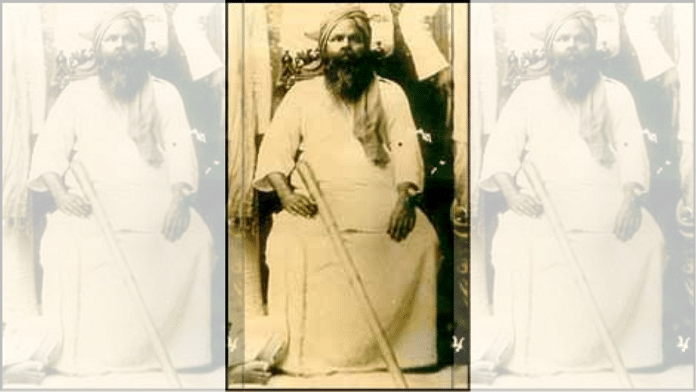New Delhi: Subramaniya Siva is most well known as the first person to be imprisoned in the erstwhile Madras region by the British rulers over sedition charges. But the Tamil nationalist fought another lesser-known battle in his lifetime — the Tanittamil literary movement.
“Let your tongue speak Tamil only. Let the quill you hold write Tamil only. Let your heart speak Tamil only. Let Dame Tamil with her Grace protect you,” wrote Siva in the November 1915 issue of Gnanabhanu, a monthly he edited and published.
In his book Vitutalaipporil Tamil Valarnta Varalaru (History of development of Tamil in the freedom struggle), M.P. Sivagnanam gave an insight into Siva’s deep seated love for Tamil, as described by Karthigesu Sivathamby in the journal Social Scientist.
‘Pure Tamil’
Started by Maraimalai Adigal, the Tanittamil (‘pure Tamil’) literary movement intended to rid the Tamil language of non-Tamil words, especially Sanskrit. The extreme nationalist movement propagated by Subramaniya Siva was the most significant of all Tamil revivalist movements organised by nationalists, wrote Sivathamby.
Born on 4 October 1884 to a Brahmin Iyer family in Vathalagundu near Dindugal in the district of Madurai, Siva believed that language is the soul of a community, and “if the Tamil language is destroyed, the greatness of Tamils will be lost”.
Such was his passion for pure Tamil that he wrote an advertisement which was published in Gnanabhanu as such:
‘Five rupees’ — “Can you write pure Tamil? If so, rush in. A lover of Tamil has come forward to offer five rupees (as a prize) for anyone who writes, not less than eight pages on the history of St. Tiruvalluvar in our Gnanabhanu, which uses only pure Tamil words with no mixtures of words from other languages like Sanskrit.”
Freedom struggle
Subramaniya Siva was one of the greatest nationalists of the Tilak era. Within the Congress movement, Siva was able to bring forth Tamil nationalists who supported the use of ‘pure Tamil’ words.
In 1906, Siva found himself to be inspired by the speech of Sri Thahurkhan of the Arya Samaj in Trivandrum. He persuaded many young men like himself to join the freedom movement, by establishing ‘Dharma Paribalana Samaj’. This led to the activist’s first brush with authority, with the British Indian government sentencing him to six years of severe imprisonment in 1908.
But Gnanabhanu helped him keep the freedom struggle alive while in prison. Siva even helped staged labour agitations in then Calcutta, Madras, Tuticorin and Tirunelveli. In conjunction with the freedom struggle was Tanittamil Iyakkam, which is best understood as a cultural expression of a political movement.
In his prolific writings, Siva fashioned that genuine Tamil revival had to coincide with an “all-India perspective”. Congress also proved its commitment to the revival of national languages in 1915 at a reception held in Mayuram (now Mayiladuthurai) when Mahatma Gandhi responded to a welcome address presented in English: “Nationalism cannot be developed by killing our national languages and using English in their place.”
Siva’s campaign for the Tanittamil literary movement put Tamil language at the forefront, politically. It brought out simmering tensions of a community that desired to direct matters politically, but was denied it on the grounds of language. His writings inspired generations by granting the language its independence, and by virtue of that, its sweetness.
The writer was diagnosed with leprosy while he was serving one of his many prison terms. Despite his many illnesses, he continued to fight for India’s independence.
In 1921, he planned on constructing a temple for ‘Bharat Mata’ and laid the foundation stone in Papparapatti two years later. However, Subramaniya Siva succumbed to leprosy and breathed his last on 23 July 1925. To commemorate his contribution to the freedom struggle, former Tamil Nadu chief minister J. Jayalalithaa inaugurated his memorial in Papparapatti in 2012.
Also read: Akilan, legendary Tamil writer who fell out of love with Gandhian philosophy




Dear Sirs,
Kindly make the correction at once. The photograph show is that of V.V.S.IYER . and NOT of Subramanya Siva. V.V.S.Iyer also was a great revolutionary and a scholar in Sanskrit, English, Latin, Greek, and of course Tamizh. He too was editor of Desabakthan , previously edited by Thiru.VI.Ka
(Kalyaana Sundranam Mudaliyar ) a staunch Trade Unionist, marxist in ideology, with emphasis on Working class movements. and Gandhiyan . Subramanya Siva was a very close associate of V.O.Chithambaram Pillai.. of Tuticorin Shipping company fame. Chithamabaram Pillai like Barathy, were devoted followers of Lokamaanya BalaGangaadhar Tilak.
V.V.S.Iyer followed Savarkar. and most of the time was against Gandhiyan methods.
though he was neither a casteist nor a Hindu-Communalist.
For the correct photo of Subramanya Siva, please see
https://sites.google.com/site/desabaktharkal/home/cuppiramaniya-civa
Surprised to see this article here especially from someone with the last name Grewal?
I’m not a Brahmin but Tamil Brahmins have done some greatest service for the growth and glory of Tamil language. Tamil Thatha U Ve Sa Iyer spent his lifetime restoring and printing ancient Tamil literature late 19th to mid 20 th century. Greatest Tamil patriot Subhramniya Iyer wrote most beautiful Tamil poetry and some very inspiring verses advocating Pan Indian nationalism.
I wasn’t aware of Mr Siva’s passion about Tamil.